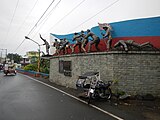
Emilio Aguinaldo y Famy was a Filipino revolutionary, statesman, and military leader who became the first president of the Philippines (1899–1901), and the first president of an Asian constitutional republic. He led the Philippine forces first against Spain in the Philippine Revolution (1896–1898), then in the Spanish–American War (1898), and finally against the United States during the Philippine–American War (1899–1901). Though he was not recognized outside of the revolutionary Philippines, he is regarded in the Philippines as having been the country's first president during the period of the First Philippine Republic.

Cavite, officially the Province of Cavite, is a province of the Philippines located in the Calabarzon region. On the southern shores of Manila Bay and southwest of Manila, it is one of the most industrialized and fastest-growing provinces in the Philippines. As of 2020, it has a population of 4,344,829, making it the most populated province in the country if the independent cities of Cebu are excluded from Cebu's population figure.
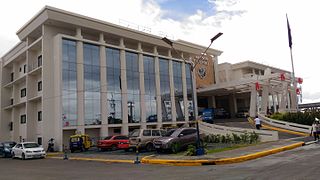
Bacoor, officially the City of Bacoor, is a component city in the province of Cavite, Philippines. According to the 2020 census, it has a population of 664,625 people, making it the 15th most populous city in the Philippines and the second largest city in the province of Cavite after Dasmariñas.

Dasmariñas, officially the City of Dasmariñas, is a component city in the province of Cavite, Philippines. With a land area of 90.1 square kilometers (34.8 sq mi) and a population of 703,141 people according to the 2020 census, it is the largest city both in terms of area and population in Cavite and the wealthiest Local Government Unit in the province.

The Battle of Zapote River, also known as the Battle of Zapote Bridge, was fought on the 13 June 1899 between 1,200 Americans and between 4,000~5,000 Filipinos. It was the second largest battle of the Philippine–American War after the Battle of Manila five months before in February 1899. Zapote River separates the town of Las Piñas in what was then Manila province from Bacoor in the province of Cavite. The ruins of Zapote Bridge still stands next to its replacement bridge on Aguinaldo Highway.

Zapote Bridge is a stone arch pedestrian bridge crossing the Zapote River in the Philippines. It connects the cities of Las Piñas in Metro Manila and Bacoor in the province of Cavite. The bridge and its surrounding area was the site of two battles, the Battle of Zapote Bridge (1897) between Filipino revolutionaries and the Spanish colonial government in 1897 during the Philippine Revolution, and the Battle of Zapote River between Filipino and American forces in 1899 during the Philippine–American War. Because of these historic events, the bridge was designated as a National Historical Landmark by the National Historical Commission of the Philippines on September 9, 2013.

Imus, officially the City of Imus, is a component city and de jure capital of the province of Cavite, Philippines. According to the 2020 census, it has a population of 496,794 people.

Noveleta, officially the Municipality of Noveleta, is a municipality in the province of Cavite, Philippines. According to the 2020 census, it has a population of 49,452 people.

The Diocese of Imus is a Roman Catholic diocese in the Philippines that comprises the entire province of Cavite. By the virtue of the apostolic constitution "Christi Fidelium," promulgated by Pope John XXIII, the diocese was canonically erected on November 25, 1961, when it was excised from the Archdiocese of Manila and the then-diocese, now Archdiocese of Lipa. The diocese was formally inaugurated on April 26, 1962 and its first bishop, Artemio Gabriel Casas, took canonical possession of its administration. Imus Cathedral, located along General Castañeda Street in the poblacion of Imus, serves as the see of the diocese. It is one of twelve cathedrals founded by the Order of Augustinian Recollects in the Philippines.

Mariano Gómes de los Ángeles, often known by his birth name Mariano Gómez y Custodio or Mariano Gomez in modern orthography, was a Filipino Catholic priest who was falsely accused of mutiny by the Spanish colonial authorities in the Philippines in the 19th century. He was placed in a mock trial and summarily executed in Manila along with two other clergymen collectively known as the Gomburza. Gomes was the oldest of the three priests and spent his life writing about abuses against Filipino priests.

Radial Road 1 (R-1), informally known as the R-1 Road, is a network of roads and bridges which comprise the first arterial road of Metro Manila in the Philippines. Spanning some 42.67 kilometers (26.51 mi), it connects the cities and municipalities of Bacoor, General Trias, Imus, Kawit, Las Piñas, Manila, Naic, Noveleta, Parañaque, Pasay, and Tanza in Cavite and Metro Manila.
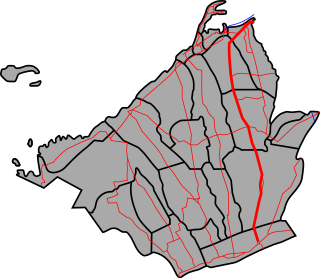
The Emilio Aguinaldo Highway is a four-to-six lane, 41.4-kilometer (25.7 mi), network of primary and secondary highways passing through the busiest towns and cities of Cavite, Philippines. It is the busiest and most congested of the three major highways located in the province, the others are Governor's Drive and Antero Soriano Highway.
José Tagle y Santarin was a Filipino military officer who participated in the Battle of Imus during the Philippine Revolution.

The Battle of Binakayan–Dalahican was a simultaneous battle during the Philippine Revolution that was fought on November 9–11, 1896 that led to a decisive Filipino victory. The twin battle took place at the shores of Binakayan, in the town of Cavite Viejo ; Dalahican and Dagatan in Noveleta; and, to minimal extent, in Imus and Bacoor towns in Cavite, Philippines that lasted for two days before the Spanish army retreated demoralized and in disarray. The result of the battle was the first significant Filipino victory in the country's history.
The Kawit revolt was a short skirmish in the beginning of the revolution in Cavite. Gen. Emilio Aguinaldo, The First President of the Philippines, led some 400 men to the town hall of Kawit, guarded by a few Guardia Civil there. A few days after the revolt, Aguinaldo marched to Imus to meet the enemy in one of the great battles of the revolution.

The Battle of Imus, or the siege of Imus, was the first major battle of the Philippine revolution against the Spanish colonial government in the province of Cavite. It was fought between September 1–3, 1896 at Imus, Cavite province in the Philippines, right after Bonifacio's attack on the gunpowder magazine at the Battle of San Juan del Monte in Manila.
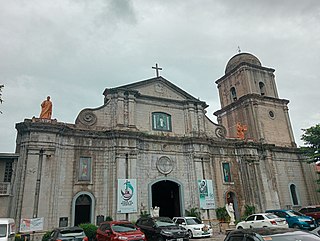
The Diocesan Shrine and Parish of Our Lady of the Pillar, commonly known as Imus Cathedral, is a Roman Catholic cathedral church in the city of Imus, in the province of Cavite, Philippines. The church serves as the seat of the bishop of the Diocese of Imus, the diocese that has jurisdiction over the entire Civil Province of Cavite.
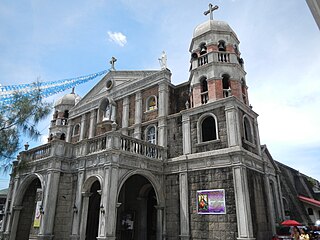
The Immaculate Conception Parish Church, also known as Dasmariñas Church, is the first Roman Catholic parish church in the city of Dasmariñas, province of Cavite, Philippines. It is under the jurisdiction of the Diocese of Imus. The stone church was constructed right after the establishment of Dasmariñas as a separate parish in 1866. The church and convent was the site of bloodshed during the Battle of Perez Dasmari ñas of the Philippine revolution against Spain. It was declared as an important historical structure by the National Historical Institute with the placing of a historical marker in 1986.

Our Lady of the Pillar of Imus is a Roman Catholic Marian title of the Blessed Virgin Mary and venerated Marian image of the Madonna and Child atop of a pillar. The town of Imus in the province of Cavite and the Diocese of Imus, considers her as its patroness.

The Molino Dam or Prinza Water Dam is a gravity dam on the Zapote River located on the border between Barangay San Nicolas I, Bacoor, Cavite and Barangay Talon Dos, Las Piñas, Metro Manila, Philippines. It was built by hand in the 19th century to irrigate the surrounding rice field in Las Piñas and Bacoor.






